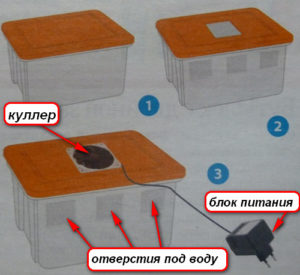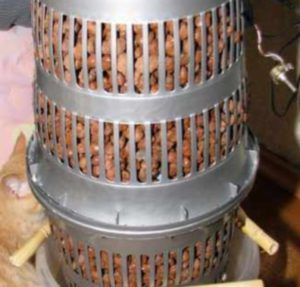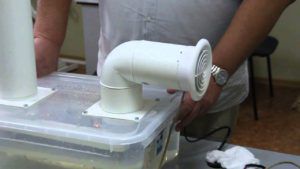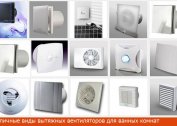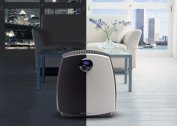According to medical recommendations, the humidity in any living room should be at the level of 50% - only in this case everyone who lives there will feel comfortable. The low moisture content in the air worsens overall well-being, increases the likelihood of various diseases, and leads to skin problems.
To set this indicator to a normal level and maintain it so, humidifiers are used.
What are humidifiers
All existing devices that serve to increase the moisture content in the air are divided into three varieties:
- water;
- steam;
- ultrasound.
The simplest kind of equipment is water humidifiers. Their work is based on the passage of air through the filter element, which is pre-moistened. The most commonly used filters are cassettes made of several layers of paper. The increase in air content occurs at ordinary room temperature, this is achieved due to the natural evaporation of water. Although the effectiveness of these types of devices is low, they are characterized by affordable cost.
Steam humidifiers perform their functions as a result of heating and evaporation of water - something like a boiling kettle without a lid. Devices of this category can provide good hydration, but are not safe to use - you can easily get a burn. Therefore, the use of such humidifiers in a house with young children is not recommended.
The most modern and effective type of humidifier is ultrasonic. Inside the device there is a plate that vibrates, from which the water breaks into very small drops, the fan carries them throughout the room. The effectiveness of such hydration is at a decent level.
A simple homemade humidifier
The modern market offers consumers a variety of humidifiers of various types, capacities and prices. In addition, you can always make a humidifier with your own hands - to develop simple models is quite simple.
There are many schemes of homemade devices to increase the moisture content in the air. Consider the process of creating a device of the simplest design.
Used materials and tools
First of all, for the independent manufacture of such a device, you will need to find a plastic container. Its dimensions do not play a big role, the main thing is that the height is at least 20-30 cm.
In addition to such a container, a computer fan is also required. The last component of the future humidifier is the power supply, which will ensure the operation of the fan. For the operation of computer coolers, the voltage should be 12 V - a block of just such a voltage is needed.
After preparing all these materials, you must also prepare the tools. Among them:
- drill;
- soldering iron;
- stationery knife.
Work sequence
After preparing everything you need, you can begin the process of assembling the device. How to make a DIY air humidifier of a simple design? The sequence of actions is as follows:
- Holes are drilled in the lid of the plastic container - a fan will be fastened through them to the upper edge of the box;
- Next on the lid is marked the place where the cooler blades will be located. Using a clerical knife, a marked hole is cut out;
- The next step is to install the fan in the place prepared for it using the selected fixtures.
On this, the hand-made production of the humidifier is almost complete: it remains only with a soldering iron to connect the installed cooler to the power supply, pour water into the container, close it with a lid. After that, the device will be ready for use.
Such a simple design can provide humidification of indoor air by about 30 percent, which is a worthy indicator.
Expanded clay humidifier
A homemade device in which expanded clay is used is a higher efficiency - a material that absorbs moisture well and releases it. Since devices of this design provide a good increase in humidity, it can be used not only for domestic purposes, but also, for example, for growing mushrooms that require very high humidity.
To make a humidifier according to this scheme, you will need:
- plastic waste bins - 4 pieces, two large and two smaller;
- a bucket of 10-12 liters;
- computer fan;
- aquarium pump.
The process itself is carried out in the following sequence:
- Two small baskets are interconnected. You can do this with glue, plastic fasteners or a hair dryer.
- In the same way, large-volume baskets are connected, setting inside their connected small ones. In this case, a humidifier case will be obtained, similar in design to a thermos.
- Next, a hole is cut out in a large basket, expanded clay is poured into it.
- This material must be selected so that the granules do not fall out through the slots in the baskets. Expanded clay is thoroughly washed with water.
- An aquarium pump is installed at the bottom of the water bucket; its tubes are discharged to the very edge of the bucket.
- The plastic ring in which the holes are made is installed on top of the humidifier - moisture will drain back from the holes into the bucket.
- A fan is installed on top of the ring, which will supply air inside the humidifier, which, when moistened, will go out through the holes in the baskets.
Having poured water into the bucket and installing the lower part of the container with expanded clay in it, the homemade humidifier will be ready for use - all that remains is to supply power to the cooler.
Homemade Ultrasonic Humidifier
Now everyone knows how to make a humidifier of the simplest design. Ultrasonic types of such devices are even more effective, can be used for domestic purposes, and when growing mushrooms or for solving many other purposes. How to make an ultrasonic humidifier with your own hands?
The scheme of work is as follows: on a float, a piezoelectric emitter will sink into the water, producing “cold steam”. A fan is used to supply air into the housing, which will also expel steam from there.
Materials:
- a small bucket of plastic with a lid is suitable for the body of the device;
- computer fan;
- two tubes of 10-15 cm each, the diameter of which is the same as that of the cooler blades;
- Styrofoam;
- disposable cup;
- ultrasonic wave emitter, which can be purchased at many radio component stores.
After preparing the materials, you can begin to develop the device:
- For pipes in the lid of the bucket holes are made. A cooler is installed on the top of one of them.
- A hole under the cup is made in the foam. It is installed in the hole - the float for the emitter is ready.
- At the bottom of the cup, two holes are made for the intake of water. A radiator is placed inside such a float, water is poured into a bucket, the float is lowered there.
- The bucket is covered with a lid, the tubes are inserted into the prepared holes.
After that, you can turn on the emitter.If everything was done correctly, “cold steam” will immediately go out of the free tube. Thus, the emitter is a useful household appliance that can be made with your own hands.

